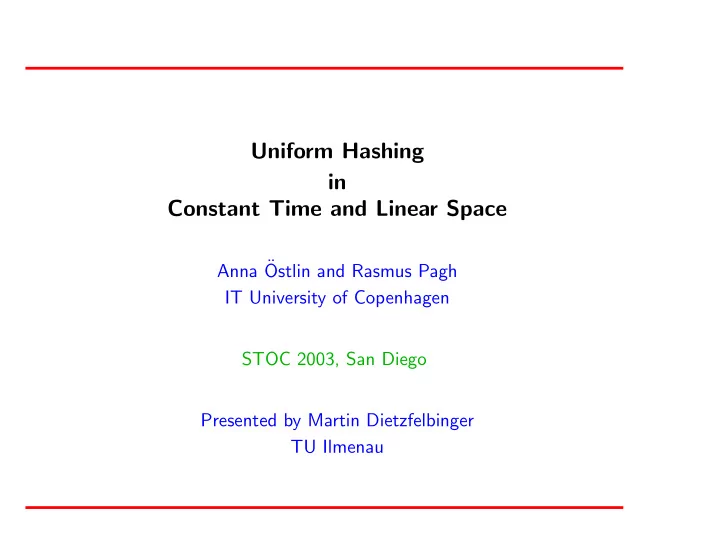

Uniform Hashing in Constant Time and Linear Space Anna ¨ Ostlin and Rasmus Pagh IT University of Copenhagen STOC 2003, San Diego Presented by Martin Dietzfelbinger TU Ilmenau
Uniform hashing U Uniform hashing assumption: h V h maps elements of U uniformly at random and independently to V . Hash functions, i.e., functions “mimicking” a uniform hash function, have applications in information retrieval, complexity theory, data mining, cryptology, etc. STOC 2003 Uniform Hashing in Constant Time and Linear Space 1
Usage of uniform hashing In analysis of algorithms, it is often assumed that the hash functions used are uniform. For example, all analyses of hash- ing schemes in The Art of Computer Programming use the uniform hashing assumption. Is this reasonable? Against: For: • True uniform hashing requires • In practice many simple hash | U | log | V | bits of space. Mostly functions perform as well as in the infeasible! uniform hashing analysis. • Analyses for restricted random- • Often one can carry analyses over ness hash functions can be cum- to explicit hash function classes bersome (or undoable). with restricted randomness. STOC 2003 Uniform Hashing in Constant Time and Linear Space 2
The new result It is possible to get very close to the theoretical ideal of uniform hashing: We construct a hash function that: • Is uniform, with high probability , on any particular set S of size n . • Can be stored in O ( n ) space (which is optimal). • Can be evaluated in constant time. STOC 2003 Uniform Hashing in Constant Time and Linear Space 3
k -wise independence One approach to “mimicking” a truly random function is to choose a hash function that is uniform on any set of size at most k , for some k < | U | . This property is called k -wise independence . Example: For random a 0 , . . . , a k − 1 ∈ { 0 , . . . , p − 1 } , the function k − 1 a i x i mod p ) mod | V | � h ( x ) = ( i =0 where p is prime, is k -wise independent. STOC 2003 Uniform Hashing in Constant Time and Linear Space 4
Usage of bounded independence Examples of analyses using bounded independence: Independence Algorithms Type of analysis 2-wise chained hashing expected performance dynamic perfect hashing 4-wise chained hashing high probability bounds dynamic perfect hashing O (log n ) -wise open addressing high probability bounds PRAM simulation n -wise most hashing schemes uniform hashing assumption STOC 2003 Uniform Hashing in Constant Time and Linear Space 5
Known n -wise independent hash functions Assume that | U | = n c for a constant c (see paper for general case). Reference Space Eval. time Error prob. Polynomial O ( n ) O ( n ) 0 √ c + ǫ n − O (1) [ Siegel 1989 ] O (1) n n 1+ ǫ [ Siegel 1989 ] O (1) 0 ( in general n − O (1) ) (nonconstructive) n − O (1) New result O ( n ) O (1) STOC 2003 Uniform Hashing in Constant Time and Linear Space 6
The new result in detail RAM model: Unit cost with word size Θ(log | U | + log | V | ) . We can construct a random family of functions from U to V such that for any set S ⊆ U of n elements: - With high probability the family is uniform on S . - There is a data structure of O ( n ) words representing the family such that function values can be computed in constant time. - The data structure can be set to a random function in O ( n ) time. The construction uses o ( n ) words of space and takes expected time o ( n ) + (log log | U | ) O (1) . STOC 2003 Uniform Hashing in Constant Time and Linear Space 7
Recommend
More recommend